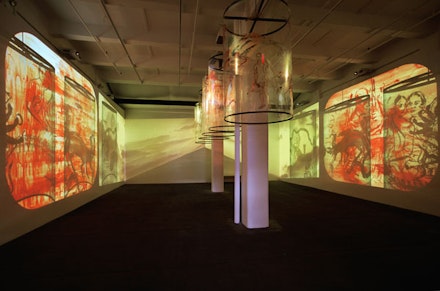ArtSeen
NALINI MALANI In Search of Vanished Blood
Nalini Malani’s In Search of Vanished Blood on view at Galerie Lelong through October 26, is a sprawling, multi-media experience blending imagery from multiple cultures with text, sound, and light, to explain what feels like the familiar, time-worn struggle of the woman as displaced other in search of the basic comforts of home, security, and even identity.
On View
Galerie LelongSeptember 6 – October 26, 2013
New York
The viewer’s experience begins quietly, with a series of two-dimensional images, and a video sketch, “Penelope” (2012), in which a complex monster-looking creation emerges, line by line, and then disappears in the same manner. Malani’s delicate painted works, called “reverse paintings,” consist of blurry figures rendered in muted tones atop curiously busy backgrounds, something like bizarre graphing paper covered in swirling lines, arrows, maps, diagrams, and numbers. These images provide something of a primer, or even a mythological context, to the more overt video work displayed in the gallery’s larger space. Western and Eastern imagery meld together in these muddy portraits and the hint of a narrative emerges; some images represent a sort of primitivist scientific illustration, in which human and animal physiognomy, relationships, and trials are explained with fantastical metaphor, and other pieces hint at violence and the assertion of one culture (or creature, or gender) over another. Several of these works, like “Complexity of Communication 9” (2013), show a scene in which one human form seems to be violating another as a third observer cowers in the back, all blurry and amorphous save for certain carefully considered lines creating facial features or implying movement and garments. Unique in this series is the addition of a sort of viewer-proxy, a creature resembling a large, fantastical hedgehog who dispassionately observes the scene and, in several of Malani’s other paintings, seems to actually gaze out at the viewer. This fantastic creature, whose simple, almost childlike features could simultaneously engage the viewer and somehow demand sympathy, appears to observe several depictions of odd medical procedures. Malani’s use of earthy hues and deceptively crude, soft-limbed figures evokes ancient pictographs, almost like cave paintings, yet her fine lines and expressive detail work lends nuance to these characters. These organic, subdued shapes contrast with the precise, hectic, modern lines upon which they are layered.
These works introduce us to the pan-cultural, timeless mythology she has woven from iconographic elements and touches of the irrefutably modern. This narrative reveals itself fully with even more layers and subtext in the large, cavernous room that houses “In Search of Vanished Blood” (2012), a multi-channel projected video stretching and overlapping across every wall combined with larger-than-life, image-covered transparent cylinders suspended from the ceiling, spinning slowly and casting ever-shifting shadows. Perhaps one explanation for the collision of sensuous Eastern lines with stark, stiff Greek-looking silhouettes and gestures could be Malani’s own history as an inhabitant of India at the time when colonialism fell, a topic mentioned both in her artist’s statement and biography. India’s 1947 Partition following the British withdrawal from India created two new nations (India and Pakistan) divided along religious lines and ultimately thrust millions of religious refugees into the hands of two newly formed, inexperienced governments. Millions of Pakistani Sikhs and Hindus fled to India as a similar exodus occurred with millions of Muslim Indians entering Pakistan. The Partition, and the resulting well-documented plague of religiously-motivated rapes of women on both sides of the border, serves as the haunted core around which Malani’s exploration of the marginalized is wrapped.
“In Search of Vanished Blood” is almost silent at moments, until voices emerge from the spinning shadows. Malani’s use of overlapping layers of audio implores the viewer to search for cogent pieces in the undulating cacophony. Something sounds like a spoken poem, something sounds like many voices chanting then singing, something breaks like glass, and then whispers rise above a steady, ominous drone. While this soundtrack envelops the viewer in female voices and violent crashes, the walls are lit with a whirling, quickly transforming series of video clips and still images. A woman’s face fills two walls, then she is shown wearing a gauzy white hijab, finally her entire face is wrapped in the fabric, obscuring her features entirely. A glowing fingerprint appears, hands rapidly form sign language letters, a woman’s static body and face are slowly claimed by earth (or perhaps blood)-colored splotches. These cycles of identity being revealed then obscured in different ways feel like a more specific version of the cultural ambiguity and morphing seen in Malani’s painted figures. The effect is crushing displacement, as though the viewer is witnessing the horror of a human’s losing battle against marginalization, as if her existence is so tentative that it is endlessly engulfed and manipulated by external forces—like clashing cultures, stifling gender roles, the weight of religion, even the medical world’s objectification. The painted cylinders in the center of the installation interrupt the videos with their spinning shadows of Malani’s constructed mythology. Some of these painted figures are posed triumphantly, even as though they are perhaps deities, yet they mutate as projected light smears their shadows across the wall, again obscuring the woman who appears to stand in for many women essentially crushed by the patriarchy.
Even with little personal understanding of Malani’s personal struggle or exposure to life as a refugee in the aftermath of the Indian Partition, this body of work clearly evokes a sense of disenfranchisement. Malani carefully constructs then modernizes a sublime, yet visceral, mythology from fragments of reality, and then throws the viewer headlong into it.


